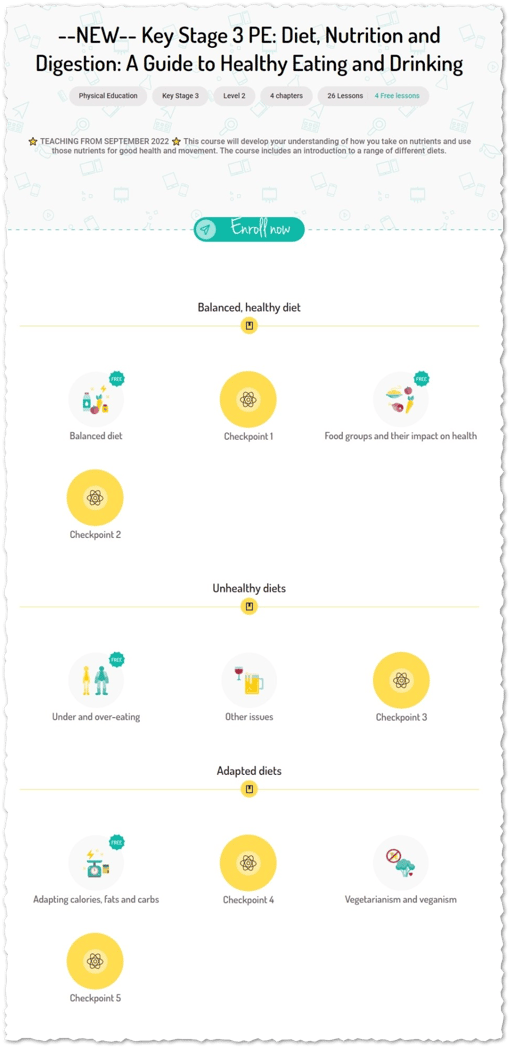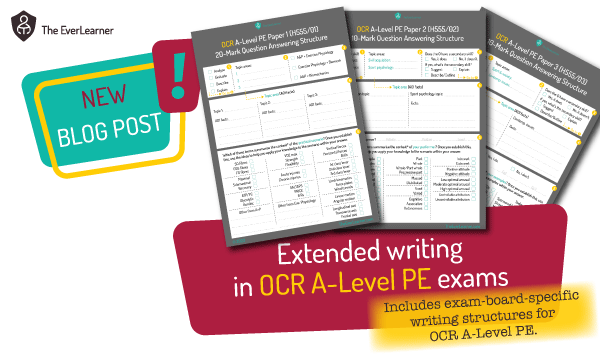How I Teach Diet and Nutrition in PE
Elements of diet and nutrition feature in a very wide range of qualification PE learning. Diet, balanced diet, adapted diets and health are major features of GCSE, and both major A-level courses by OCR and AQA feature significant dietary components. Furthermore, the new OCR National in Sport Science features an optional, standalone nutritional unit. In fact, the only major PE course that does not feature nutritional study is the level 1/2 BTEC Tech Award in Sport.
The image above is taken from a KS3 course that I have written on healthy eating and drinking.
Therefore, PE teachers up and down the land are teaching diet and nutrition and the aim of this post is to help those teachers develop a broader and deeper understanding of diet. I also aim to align the teaching of PE teachers with that of teachers of biology and food science. In other words, I want my PE teacher readers (you?) to leave this post being confident in how to teach diet in a rigorous and intuitive way because you understand it deeply.
In this specific post I want you to marvel in relation to the macronutrients of carbohydrate, proteins and fats. Typically, in PE, we teach things such as:
- Carbohydrates provide energy.
- Fats provide energy.
- Proteins are for growth and repair.
But if we were to ask a PE student “How?” or “Why?”, would we be confident that our students could answer these basic premises? Are we, the PE teachers, capable of answering these questions? Seriously, if a student was to ask any of us “Sir/Miss, how do proteins cause growth/repair?”, what would the average answer be in a PE lesson?
These are amongst the reasons why I write every week. I want to elevate our collective thinking but, more, excite PE teachers about their own subject. I do this because PE excites me and I don’t believe I am alone. What follows, I hope, is an impassioned description of some areas of nutrition and diet and I truly hope you enjoy it.
So, let’s start at the beginning. Human beings, like all other organisms, need to recruit external resources in order to live. These resources are often obvious, such as the need for oxygen for respiration or water for cell function. But human beings, crucially, also need to ingest carbohydrates, proteins, fats, fibre, vitamins and minerals in order to live. Human beings extract these nutrients from food (and drink). In other words, human beings, like other animals, are heterotrophs: their nourishment is derived from food chains. This differs from plants, for example, which are phototrophs: plants derive their nourishment from light energy.
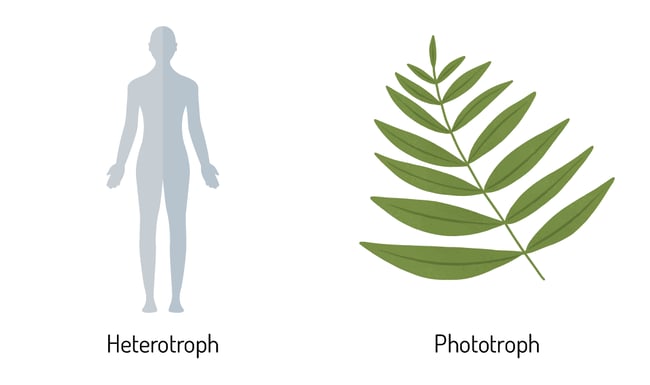
So, we have this clear: human beings derive nourishment from food chains.
The problem is food chains - such as fats, proteins and carbohydrates - cannot be absorbed by the body. They are too large to get into the bloodstream and be transported to the cells. Therefore, humans use digestion to break down food chains into smaller components.
So, let’s take a moment to get our terminology right here.
- Human beings take on food chains. These are known as “insoluble” because they are too large to pass into the bloodstream.
- Human beings “digest” these food chains to make them smaller.
- Once digested, we refer to the products of digestion as “soluble”. In other words, they are now small enough to pass into the bloodstream.
I would like to summarise this idea into an image:
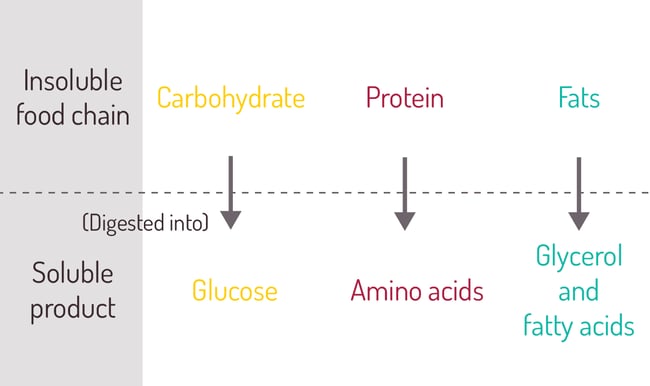
Pausing for a moment on digestion, this process is achieved through both mechanical and chemical processes. Mechanical digestion involves processes like chewing in the mouth but also churning of the stomach, whereas chemical digestion involves enzymes in the mouth, stomach and small intestine that chemically break down the food.
Whilst these ideas might seem simple, I personally find digestion to be a stunning field of study. Think about it: we bite on a slice of pizza, say, and that bread, cheese, tomato and toppings are broken down into their component parts that are so small that they can be absorbed through a partially permeable membrane, transported via the blood and, in the case of proteins, say, amino acids are delivered to the microscopically tiny ribosome structures in each cell to be processed. Furthermore, we are able to do this without thinking. Wow! Just wow! If anyone tells you that science is boring, then they haven’t had things explained to them in a way that does justice to the reality of what we are describing here.
So, digestion occurs and we now have glucose (a tiny sugar unit derived from starches and other larger sugars), amino acids (broken down from proteins) and glycerol and fatty acids (broken down from fats) in the blood. What happens next?
Carbohydrate
Glucose is the basic fuel for all cells in the human body and glucose is derived from carbohydrates. We can say that glucose is the preferred energy source of all cells. Therefore, glucose is transported in the blood and is delivered to cells such as muscle cells or skin cells and there, glucose is utilised as an energy source. Once broken down, glucose can be used to power muscle contraction, for example. This is how sports performers generate the force for movement. In other words, the chemical glucose is transferred to the kinetic energy store (movement) when a high jumper leaps upward. Notice that no energy has been produced here: it has been transferred from a chemical store into a kinetic store.
If we consume more glucose (from starch and sugars) than we need, we can also store glucose but we need to process it first. Glucose is converted to glycogen and stored in the muscle tissue and, to a greater extent, in the liver and this gives athletes a store of the body’s preferred energy source, glucose. Now, the human body is not specialised to store sugars so, during exercise, glycogen will deplete after about two hours on average. For this reason, athletes like cyclists, marathon runners and triathletes will consume other sugar-rich foods such as fruit in order to boost glucose levels.
Summary of carbohydrates
- Ingested in the form of: Insoluble starches and sugars
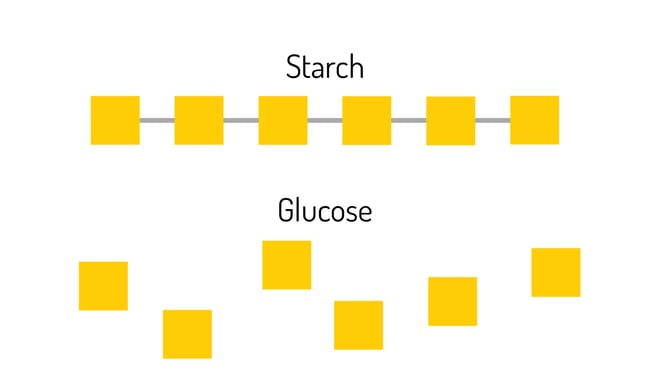
- Digested into: Soluble glucose
- For the purposes of: Energy transfer in the cells. Consider for example, glucose as the energy source for both aerobic and anaerobic respiration when teaching GCSE PE lessons.
- Can be stored in the form of: Liver and muscle glycogen
Proteins
Proteins are stunning! I mean, really now! Proteins are remarkable. I am inclined to write a huge long piece on proteins alone but, instead, let’s keep things simple: proteins are an insoluble food chain and they are found in meat, fish, pulses, eggs, dairy, etc. They are constructed of amino acids. In total, there are 20 known amino acids in existence and proteins are made up of sometimes hugely complex arrangements of these amino acids. Human beings need to consume all of these 20 amino acids (in proteins) in order to perform the wide range of functions that amino acids are needed for. So let’s take an example:
- A person eats a chicken leg (sorry to those on plant-based diets).
- This chicken meat contains chains of amino acids that form into proteins that are specific to chicken meat.
- The human digestive system breaks down the protein into the individual amino acids. These amino acids are soluble and are absorbed into the bloodstream.
- The amino acids are then delivered to the muscle cells, say, and, at the ribosomes (tiny organelles in human cells) these amino acids are rearranged into human protein capable of forming new muscle tissue.
Wow! Wow! Wow! Tell me that this is not stunning. Tell me that PE students don’t need to know this. Tell me that this shouldn’t boggle my mind. You can’t.
I’ve also summarised this into an image for ease:
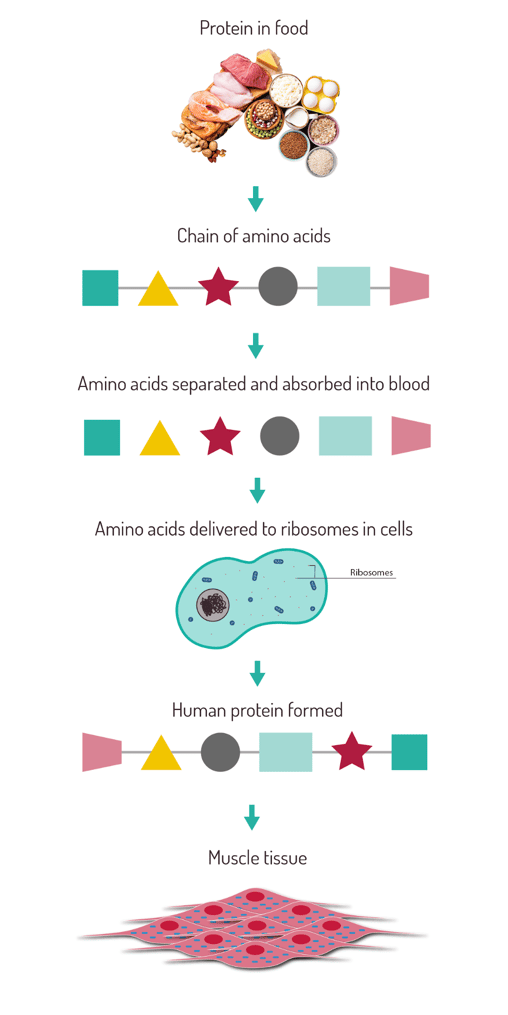
Everything we do in PE is based on fundamental principles such as this one. Learners deserve to learn this! PE teachers have a responsibility to teach this. If we encourage this awareness, teaching ideas like “proteins are for growth and repair” or “athletes consume protein after training” are not even necessary as teaching elements. The students will just know it. It is implicit. Yet, I believe that what many students learn in PE lessons is only “proteins are for growth and repair” or “athletes consume protein after training.” I am writing this post to elevate this and to challenge every PE teacher to reconsider the fundamentals of their teaching.
Summary of Proteins
- Ingested in the form of: Insoluble Protein
- Digested into: Soluble amino acids
- For the *purposes of: Growth, repair and the adaptation process.
*It is true that proteins can be consumed for energy but only in very small quantities and in extreme conditions. An example could be a person with an eating disorder when the body, in the absence of glucose and fats, will consume its own organs such as muscle tissue. I often discuss this with students but do so very sensitively and cautiously.
Now the bad news: excess proteins cannot be stored in the body. Therefore, if we consume too much, proteins can either be processed for energy (cells don’t want to do this so only do so in extreme conditions) or converted and stored as fat. 🙁
Fats (lipids)
Beastly fats! Those terrible fats! Well, not so much. Fats, as you will know, are the most energy-rich food chains. They are (like both carbohydrates and proteins) insoluble, so the human digestive system breaks them down into smaller soluble products that can then be passed into the bloodstream.
Take a look at this image:
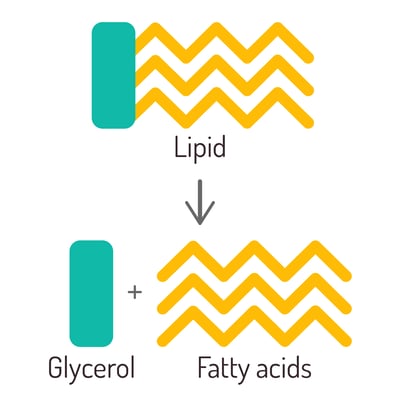
Once again, we can see a (insoluble) fat molecule being broken down into (soluble) products in the form of glycerol and three fatty acids. These products can be ingested and carried to where they are required such as muscle cells. When they arrive at the muscle cells they are oxidised (aerobic respiration) to transfer energy to the kinetic energy store (movement/contraction).
Glycerol and fatty acids are energy-rich but they can also be stored. When fats are stored, they are held just below the skin in a layer of subcutaneous (below the skin) fat. It is this same fat that so many of us wish to reduce. But, annoyingly, human beings have achieved the vast majority of their evolution during periods when fatty foods are very scarce and this means that we crave the sensations that fatty foods provide. Wanting that chocolate or cream cake or whatever your preference is, is a completely natural, human response to the historical (I hope) threats of starvation.
Summary of fats
- Ingested in the form of: Insoluble lipids
- Digested into: Soluble glycerol and fatty acids
- For the purposes of: Energy, stored energy and, to a lesser extent, insulation and protection.
So, there we have it. In my opinion, a fascinating journey through the fundamentals of the macronutrients. Yes, I could have covered other things such as balanced diet, athletes diets etc… but, having read this article, do you agree with me that the teaching of those concepts is now very, very straightforward as the concepts derive directly from what the macronutrients are, how they are processed and why they are needed?
Thank you for reading. I hope this piece may have an influence on how you teach nutrition in the future.
%20Text%20(Violet).png)
